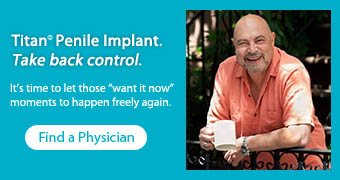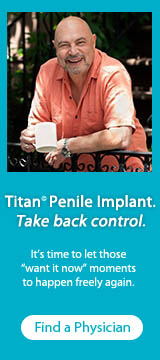Hi, Frank Talk folks. This post will be long, and I’ll give a perspective of a younger person (28 diagnosed, 31 surgery) who battled a venous leak, progressive ED, and corresponding peyronies disease. This forum helped steer me through a difficult time and hard medical decisions, so here’s my experience for anyone around my age. I hope it gives back to a community that helped me through the worst time of my life. You all are great and supportive, but I think the experience of ED and PD is different at my age than, say, a married individual in their 50’s, 60’s, etc. Younger guys like me lurking the forums can have difficulty finding age-specific perspectives for where we’re at in life. So here’s my story, things that helped, and details of my current recovery from surgery. I think it has a happy ending as I’m currently in surgery recovery and handling it well.
I’d struggled with some form of venous leak since probably around 24, though I didn’t know it at the time. I had a teenage-like ‘ready whenever, wherever’ dick the years leading up to 24. I’m someone with a high libido, but I progressively started experiencing fleeting erections that would just sometimes go away unless constantly stimulated by my partner or myself. It got worse over time even with a slew of those blue and yellow pills, and I just assumed it was psychological like many men. At age 28, right before the pandemic really came to a head in March of that year, I looked down one day after a handjob and noticed my penis was angled strangely along the underside. I’ve always had some congenital curvature, but this was a distinct new angle in one spot. I had pain in multiple locations but most acutely near that underside on the bend and just under the head on top and bottom. I later discovered at my doctor’s office that these locations were where tunical injury had initially occurred due to having a substandard erection and too much pressure during a handjob while my piping wasn’t working right. If I had been having vaginal sex and just went soft, things may not have gone the way they did, but a hand wrapped around and pumping a sub-par erection is a recipe for injury. I just thought things felt a bit rough that session, not that anything was wrong.
I was in a new relationship around that time and continued having sex with my slightly (about 15-20 degrees?) angled dick because my girlfriend was none the wiser. The scar tissue became much more apparent as the months went on, and I slowly lost the ability to have good quality sex. It’s my belief that our sexual activity leading up to my complete loss of ability to get erect likely did more damage to healing areas or creating new spots of concerns on my tunica. I began doing restorex each day for the recommended regimen (stretched 30 minutes over two sessions and counter-bent over two sessions for 30 minutes) and continued doing that the entire duration of my peyronies experience thereafter. I lost the ability to do the counterbend around one year in (too much pain) and just continued doing the upward stretching for the duration of my experience battling peyronies.
I eventually lost the ability to have sex with my partner. There was bad plumbing, PD scarring, pain, and just mental blocks to me being able to get it up and do anything. Like many, I started searching for anything that would help me. I wasn’t losing length dramatically, but more of the scar tissue around the head and a few spots on the sides began to try to heal, pulling tissue inward around them. I began experiencing indentations in spots, erection instability, weak spots, and a band-like hourglass near the head in particular. A later ultrasound scan confirmed that these spots were peyronies plaques that had become collagenized but not calcified. I was fortunate that they were not calcified as things could have been much worse if so. All told, I lost a bit over an inch by the time of my surgery over 2.5 years later. I was born with a long penis that was also very girthy (above average but also not pornstar freakish) and started at about 7 inches. I ended with somewhere in the neighborhood of almost six, but I also stopped measuring about a year in due to it only hurting my mental state. I firmly believe my restorex treatment helped me prevent losing more length, but the true devastating impact was the indentations and hourglass for me. I eventually lost my relationship with my girlfriend and was very depressed like many men who deal with PD. She wasn’t the right, supportive partner to deal with the situation anyway, however, so it hurt at the time but was a good thing to have happened looking back. I was under a depression cloud and wasn’t very emotionally or sexually available, neither of which were things I could control very much. It was easier for me to take time to do therapies and subsequent surgery without dating.
Like many men, I looked for anything that could possibly help throughout my disease progression, even things with a small amount of research that weren’t very promising. Here’s a breakdown of what I tried all throughout my disease timeline, my thoughts based on the research (medical journals/reviews), and how each approach/therapy/med impacted me.
*Viagra nightly- I immediately started to use this to induce erections at night in hopes of maintaining more healthy tissue. I have no idea if this helped or not ultimately, but the literature seems to say erections are necessary to prevent further fibrosis.
*Tadalafil daily- I moved from viagra to tadalafil due to the extended nature of its release. I felt less flush taking it, and I didn’t have the headaches of viagra. Again, my approach was to target getting nightly erections.
*Restorex-Worth it and not as barbaric a therapy as it seems. I started it as soon as I could during the initial disease onset, maybe around four months in. Think of traction therapy as dick yoga: you eventually get very used to stretching in a way that others may look at and see as highly painful. I believe doing the stretches helped me to maintain length, but I lost the ability to do the counter-bend portion of daily stretches due to plaques on my mid and high shaft. H-100 gel (see below) took over any treatment of angle issues. Restorex as a traction device was absolutely worth it, however, and it’s worth the $500. Get one and commit the time and consistently stretch. The research (Mayo Clinic backed) is absolutely there to back it up, and it helped me to probably avoid worse length loss and deformity as tissue pulled vertically inward during plaque healing.
*H100 gel (Nicardipine, superoxide dismutase and emu oil)- I began H100 about 10 months after disease onset after finding out about this medication. A few urologists put together this combination medication that is compounded in emu oil. The idea is that emu oil is able to penetrate deep enough to reach the tunica and deliver the two medications in the acute phase of disease. There’s a small clinical trial that showed positive resulting changes of angulation in men during the acute phase when applied twice daily. Drs. Jeff Twidwell and Laurence Levine worked on this medication and the placebo controlled trial where they were able to demonstrate improvements in stretched penile length and angle correction that were clinically significant versus placebo. I spoke extensively with Dr. Twidwell about the medication while taking it, and he said there was no data yet to determine if it could help with indent or hourglass deformities or plaques that had calcified, only acute phase angle issues. My experience with it was that my angle improved by about half, but I saw no changes in hourglass or indentation while taking it. I took the medication for about a year and three months until it went off the market to be submitted for FDA approval. It’s something to watch to see if it can help you, and I hope that it gets approved and on the open market as fast as possible. My last thought on this med is simply that it could have targeted the plaque and prevented it from going to calcification and simply collagen based scar tissue. Again, I have no data for this, however, so it’s only a guess. I hope if it comes out it’s less expensive on the open market with insurance. Each three month supply cost me an outrageous $500 from a compounding pharmacy that had the sole license to produce it.
*CoQ10, vitamin E, and lots of other vitamins/supplements- In short, none of these made any discernible impact at all for me, and they’re all expensive after a while to keep taking. The literature on CoQ10 seems mixed and variable, and the vitamin E research seems even worse. You can try these, but they will not fix what’s happening or likely improve it. I wish it were different.
*High dose pentoxifylline- The research I read seemed to show some good anti-inflammatory results, and I started taking this about 10-12 months in. It could have played a role in my plaques remaining collagen and not becoming calcified, but I cannot say for sure. I’ve read that many plaques never go calcified, so it’s possible they wouldn’t have anyway. I would say to get on this as soon as you can, however, as it’s cheap and probably a safe bet. The worst impact of pentox was just managing the stomach upset that would sometimes occur with it. I took a probiotic and just learned to eat a fibrous diet around it. I also felt a bit grumpy and depressed, but the depression was a result of the disease before I started the meds, so I can’t say pentox objectively made that worse.
*VED device-This was absolutely the worst therapy for me. I had an extremely hard time being consistent with inflation therapy protocols I found online. There seems to be a lack of research on consistent inflation/deflation protocols within the peyronie’s population, or at least I haven’t been able to find it. I elected to try daily cycling with a medical VED in case it worked, but I found maintaining a seal for that long difficult, messy (so much lube), and time-consuming. I would also watch porn to get blood flowing during my therapy to get things rolling, and it seemed that I was able to get aroused less and less due to over-watching on the daily during my regimen. If I’m honest, I probably only maintained doing VED two times on average per week on a good week. I also only started at around 14 months of disease when the indents and hourglass really showed up in full force. I also had an incident when trying to utilize it with the bands for sex that sucked. As I mentioned, I’m a larger dude, and the bands that came with my device were way too tight when I tried using them for the first time. I slid the bands down over my erect dick for a sex session and it snapped onto me, something I didn’t know it would do. That scared the shit out of me, and I ended up clawing the thing off my dick. I took a large break from the device after fearing I hurt myself further. If you use this device, please, please be careful to ensure you don’t hurt yourself by overpumping. It’s really hard to gauge how fast to go with pulling blood into your dick, and you can hurt yourself if you screw up the pumping by going too fast. Go slow if you elect to do it, but I have mixed feelings on the therapy overall, especially given the paucity of data for PD hourglassing. Last note- The VED will pull a non-normal amount of blood into the surrounding tissue also, so the gains you’ll see visually while in the tube are not accurate (as my urologist told me), so you can get a false sense of results visually. Just be aware of that as it can be a bit deflating, no pun intended.
*Topical verapamil- I almost ordered this after H-100 was no longer available due to FDA approval processes starting for it. It was pulled from the market last year to begin that process and verapamil seemed to be the only thing similar out there. I elected to not pursue it due to some real issues with the topical version being able to penetrate deep enough to get down to the tunica. All evidence seems to point to it not working as intended and there being flaws in the trial funded by the producers. There are good journal critiques and resources about why Topical Verapamil doesn’t work, so I won’t rehash them here. It is expensive, however, so if you’re looking at it I’d consider reading about it first.
*Xiaflex- I would not pursue this. Surgery will get you further with better results, and the risk profile of Xiaflex feels a bit crazy to me. There isn’t evidence that it helps with hourglassing, and the possible tunical trauma seems like it could make things worse, especially if you don’t have someone who does it routinely. That’s just my personal opinion after looking at it for my bend initially in the first year. Xiaflex seems like a blunt instrument to use while surgery is more of a precision approach.
Tips for people going through the acute phase or waiting for surgery:
*Get into therapy ASAP- Look, if you’re like me, your brain is not a reliable narrator when you’re depressed. Not seeking out therapy is like being in a storm and not raising your sail to get to shore faster. The only thing I 100% know about your situation is that it can help to talk to someone to get out from under that cloud faster. Many men never seek out help and become hopeless or suicidal. They think they can carry the stress and pain on their back and just deal with it. I think a lot of men had that example set by adults in their life growing up, and it’s our job to start being the change we want to see in terms of our mental health struggles. It doesn’t work to hold things in, and what you suppress will only come up in other ways. Process the experience you’re going through with someone trained to help with that. It helped me so, so much. Therapy didn’t ‘fix’ my depression during peyronie’s, but it helped me out of it slowly and to feel better when I was in the thick of things. I went to someone who specialized in sex cases and male issues, and my therapist is also in her late thirties and able to relate to me well. Now that I’m through surgery, it’s been an even bigger boon to my mental health, and it can be to you. Please get help and know that you matter and are valuable as a person. Lots of men are depressed and suicidal to a degree while in the thick of PD. If you’re suicidal, please talk to family or friends, call the suicide hotline, or let someone in so things can start to feel better. Do it for those that love you. Do it for yourself.
*Work out- Exercise releases feel good chemicals in the brain that help fight depression. It won’t cure you of depression, but it helps a hell of a lot. There’s so much research out there proving the connection between depression symptoms lessening and exercise. It doesn’t matter what you do, just get moving in a way that gets you exercising. I ran and lifted my way through my disease progression, and it helped me not lose my mind totally.
*Have a routine- A routine can help keep you grounded and moving. Stick to one and map out your days even if things seem hopeless that day. I promise it can help when you feel under that cloud of depression.
*Invest time in hobbies regularly and find new ones- Anything that helps you get out of your headspace can benefit you battling depression. Find something that is a creative and/or stress relieving outlet for you and commit to it routinely.
*If you’re single, still flirt if you can- I didn’t do this until after I knew I had surgery coming up, and I missed out on time to feel like a sexual person. You don’t have to do anything more than flirt with women you interact with, but it can help your mental state to just exercise that part of yourself still. I went out on dates casually, and it helped me to remember I was still whole as a man even if my dick wasn’t. There’s light at the end of the tunnel, but when you’re in your 20’s and 30’s you think about your penis chronically. Flirting and being around women helped me to remember that I’m still a sexual being that will, once I got through my rough patch, be able to open myself up again and put myself out there.
*Jerk off (if safe!) occasionally- If you can do so safely, gently jerk off without hurting yourself. Keep your sessions light and short, but cum occasionally for your mental state. I did once a week after a VED session, and it helped my stress levels. Again, this also helped connect me back with being a sexual person who could fantasize and imagine future sex. I think it’s important to not totally shut that down when going through the awful healing process PD throws at guys. It helped me out a lot, but to each their own.
*Keep a good diet- I love some junk food like any guy, but the cleaner you eat the better you’ll feel during this disease. Research the gut biome and the role of positive bacteria on the gut. They’ve discovered a lot in recent years about a brain/gut connection, and there are even dietary approaches to treating debilitating depression now. Take a probiotic like Cultarelle that is researched and eat well each day. I promise it helps.
Finally, my surgery and path to healing:
I sought out the advice of Dr. Laurence Levine, one of the world’s leading surgeons, researchers, and specialists when it comes to peyronie’s disease. I first saw him about six months ago in Chicago at Rush University Medical Center. We did a penile ultrasound where he confirmed not only the diagnosis of PD but also that I had a venous leak. I was shot full of trimix solution to get hard and could not achieve an erection past 40-50% in the office, so my case was fairly open and shut on the ED front. He said the venous leak was the cause of my ED as well as probably some psychological trauma and offered me a surgical path to resolution. Here’s what all we elected to do and why so that others weighing their options know that these exist and some of the considerations I went through.
*Tunical Expansion Procedure (TEP)- Dr. Levin suggested we surgically incise the tunica via TEP. Tunical expansion is basically a series of incisions on the tunica tissue where peyronies plaques are located. The creator of this approach had the idea when at the traveling at an airport and picking up wine. Those wines at the airport come with a mesh sleeve around them that almost looks like a net. The doctor noticed that the mesh was extremely strong when stretched out, and he decided a surgical approach mimicking that pattern on the tunica might help to correct deformities in girth and length. When a plaque exists and is trying to heal, it pulls the surrounding tissue and causes deformity. The surrounding healthy tissue away from the plaque can actually be surgically incised in order to correct deformities like hourglass and indentation. TEP can also be used to increase length. Vertical series of incisions help correct girth deformities and horizontal ones are used to correct length loss. The caveat is that you cannot do both horizontal and vertical incisions in the same area. Once the penis is degloved and the tunica is surgically exposed, it’s up to the doctor to determine the best combination of incisions and place them accordingly. The other thing with TEP is that it has to be done in tandem with a penile implant. It requires it because you’re inflated post operation for two weeks in which the body starts to rapidly repair those tunical tissue incisions as a remodeling technique. The implant provides internal modeling for the healing process because it’s inflated anywhere from 40-60% during that time.
*Install of a penile implant- Second, to solve the ED issue, Dr. Levine wanted to install an AMS 700 CX penile implant within the chambers of my dick. This allows for erections to no longer require any blood flow and be reliably available any time. Likewise, it was installed for the TEP procedure regardless of my ability to maintain an erection or not. My understanding of his thought process on the AMS 700 is that the flaccid state looks more natural in his opinion and does a better job of expanding tissues rather than just filling the shape of where it’s placed. I listened to a lecture of his and think that’s his mindset with it from what I could gather. Implants often are put in and men have girth gains and length gains after they cycle the device over time. That’s the same thing we’re going for with my implant, and there are many posts on this board about gains.
*Bonus intra-operative decision: Tunical graft to remove congenital curvature- Dr. Levine finished the TEP procedure and determined that he was going to graft the underside of my penis. This approach meant taking my natural curvature downward and getting my dick as close to straight as an arrow as possible. Lifting that angle increases length, and he thought I would want that after having to do a bit more work on the TEP process than anticipated. I was in surgery about an hour and a half more than anticipated, and I’m glad he elected to do this. I’m super excited to have a basically straight dick, and he said he gained an inch just from that maneuver alone, so all good news. Again, the implant will help to model the graft over time.
Post-surgery:
I had my surgery three weeks ago and am doing well. I still have significant swelling and things are stiff still despite being deflated. I won’t lie and tell you that this stuff didn’t hurt. It was one of the most painful things I’ve ever gone through, and I’ve been through over a dozen surgeries in my lifetime, some big and some small. But it was worth it and I’m sure my life will be enriched as a result, so what’s a few weeks of pain? I had one of the best surgeons in the world for Peyronie’s and trusted the process he chose to get me back to my healthiest.
Immediately following surgery, I was in a medical jock strap bandage and had a scrotal drain and catheter. I ended up spending three nights in the hospital before checking out and after one week I was allowed to take off the bandage. That was fairly intense and I nearly blacked out on the hotel toilet seat when taking it off due to pain and just the visual overwhelm. It looked like my dick and nuts had been beaten to a pulp in a street fight. I was only partially inflated, but the swelling made it look like I had the porniest of pornstar dicks or some elephant trunk thing. The incision along the circumcision scar was super angry, red, and sore. It remained one of the most painful sites throughout my initial two week recovery due to the stitches. I was instructed to prop my dick up to as close to 90 degrees while laying down so it could start modeling the tissues ASAP as well. This was tough due to swelling and inflation, but I managed well enough. The relief at two weeks post op being deflated was immediate despite the tremendous amount of swelling still present. They pushed my second post op a week due to an excess of swelling, and in five weeks we’re going to do the initial inflate/deflate. I can’t wait and am already feeling so much better after three weeks. It’s still swollen and sore, but things are going back to normal looking slowly each day. I can already tell a huge shape difference and am excited about my new flaccid state.
A few healing notes:
*When they deflate you, it’s normal for your dick to be stiff and not straight down the middle. It’s due to fluid/swelling and will return to normal with healing and the implant cycling/modeling. So don’t worry about that according to the doctors I’ve spoken to
Peeing sucks for a while. It’s an unreliable water hose that shoots at 90 degrees or insane angles all at once. Again, it’s all normal and goes back to the usual a few weeks in.
Take stool softeners. You’ll need them from the pain meds, and you don’t want to be straining during a bowel movement. Softeners help things flow easily even if it’s not ideal. Trust me, don’t skip them.
*My healing process is probably atypical since I kind of had three surgeries all at once and there’s been a lot of extra healing for my body to do. So your experience could be much smoother if you’re just doing the TEP/implant or implant alone. I think the graft really elevated my pain level.
*One final thing to consider with surgery is that most insurance companies seem to cover the implant procedures so long as you can prove an organic ED causation like a venous leak. The TEP procedure is considered cosmetic by insurance still, and it cost me $7000. I happen to be in a position in life where that wasn’t a major blow, but I understand that it may not be for everyone because everyone has different financial things going on. I’m waiting to hear back on the graft I was given, but my understanding is that my insurance typically covers that procedure when it’s paired with IPP emplacement. Your mileage may vary if you have to have that done.
Finally, I just want to encourage men to not fear surgery more than they should. It’s still the gold standard for treating PD that hasn’t responded well enough to other therapies. Will it hurt? Sure, but you’ve been through a ton of physical and mental hurt already, so what is a few weeks of physical hurt? You’re strong enough to handle that, and it gets easier every day little by little. If surgery is an option for you, weigh your risk tolerance as well as there’s a small amount of risk to any procedure.
My post is long because I wanted to thoroughly get all of my thoughts down while they were still fresh. I hope this account of a younger person’s battle with PD helps someone like me who dealt with what I did. I’m happy to answer any questions in the thread I can and will try to update in the coming weeks and months to tell people how things went. I’ll be getting back into dating with an implant and I know that’s usually a concern with men who have an implant young, so I’ll try to share my experience with that and sex as well if I can.
Thanks again to this community for the great advice and support! Be well and good luck!
Peyronie's Disease, TEP, and Implant (A thirties perspective-diagnosed 28, surgery at 31)
Peyronie's Disease, TEP, and Implant (A thirties perspective-diagnosed 28, surgery at 31)
Peyronie's disease, venous leak diagnosed at 28 yo. Tunical expansion procedure, grafting, penile implant at 31 yo.
-
25yearsold
- Posts: 95
- Joined: Wed Jun 28, 2017 7:12 am
Re: Peyronie's Disease, TEP, and Implant (A thirties perspective-diagnosed 28, surgery at 31)
Thanks for sharing your story with details, please keep updating your journey
Re: Peyronie's Disease, TEP, and Implant (A thirties perspective-diagnosed 28, surgery at 31)
Thanks for sharing all of that.
Hope you have a speedy recovery. Keep us posted on your progress. If you can post pics of the before and after that is helpful as well.
Hope you have a speedy recovery. Keep us posted on your progress. If you can post pics of the before and after that is helpful as well.
55yo, NYC. ED started at 40. 50 units BiMix + Atropine (Pap 30/Phen 6/Atr 0.2). Prostaglandins caused aching. Doses increasing. A cock ring helps. Phallosan Forte tension devise to maintain size. Eager to talk about implant experiences.
-
shrunken_dick
- Posts: 225
- Joined: Mon Nov 23, 2020 12:50 pm
Re: Peyronie's Disease, TEP, and Implant (A thirties perspective-diagnosed 28, surgery at 31)
From what I have heard from Prof. David Ralph, TEP doesn’t work for length if you have circumferential plaque.
I ( 29 M) took Spironolactone 400 mg to treat my hair loss. As a result, the penis shrunk from 6” to 4”. with Severe erectile dysfunction. Looking into the penile implant with Sliding Technique.
-
2435tjklAS
- Posts: 547
- Joined: Tue Nov 30, 2021 10:17 pm
Re: Peyronie's Disease, TEP, and Implant (A thirties perspective-diagnosed 28, surgery at 31)
young_guy wrote:The other thing with TEP is that it has to be done in tandem with a penile implant. It requires it because you’re inflated post operation for two weeks in which the body starts to rapidly repair those tunical tissue incisions as a remodeling technique. The implant provides internal modeling for the healing process because it’s inflated anywhere from 40-60% during that time.
Damn, did not know that. If you've had an implant for a year and are seeking TEP, you have to wait several years for your device to wear out and need replacing?
After one TEP, did you need to do it again down the line to keep the results?
39. AMS 700 LGX, 21+3. Nov. 2, 2021. Idiot who abused alcohol for brain injury, abused viagra for implant.
Goal to prove implants increase dick size
Pre-op dick size: 8.75" x 5.7"
Current: 9-9.5" x 5.5"
Goal: 10+" x 6+"
Goal to prove implants increase dick size
Pre-op dick size: 8.75" x 5.7"
Current: 9-9.5" x 5.5"
Goal: 10+" x 6+"
-
aussiePeyronies
- Posts: 666
- Joined: Thu May 05, 2022 9:44 am
Re: Peyronie's Disease, TEP, and Implant (A thirties perspective-diagnosed 28, surgery at 31)
2435tjklAS wrote:young_guy wrote:The other thing with TEP is that it has to be done in tandem with a penile implant. It requires it because you’re inflated post operation for two weeks in which the body starts to rapidly repair those tunical tissue incisions as a remodeling technique. The implant provides internal modeling for the healing process because it’s inflated anywhere from 40-60% during that time.
Damn, did not know that. If you've had an implant for a year and are seeking TEP, you have to wait several years for your device to wear out and need replacing?
After one TEP, did you need to do it again down the line to keep the results?
The TEP is permanent, it only needs to be done once. I don't see why you couldn't get TEP during your next revision, although this will require a circumsision where they deglove the penis. Some doctors offer an inverted TEP where they make an incision near the scrotum and pull the penis inside out to make incisions on the tunica. The inverted method does not require circumsision, however, they will only be able to perform TEP 3/4s of the penis with this method (less length/girth gains with this method). The recovery period is slightly longer than just an implant.
The doctor can make horizontal and vertical incisions to increase both length and girth. User Tortao gained back 2cmn in length which he had lost from peyronies. He may have gained more, just never returned to update his journal. The studies say a gain of up to 3cm (google them). However, keep in mind that the urethra is not touched during this procedure, so a significant increase in length is unlikely. I believe how much you gain is dependent on the neurovascular bundle. The procedure does pose further risks of nerve damage and infection, it is quite a long procedure. Mine was 4 hours including TEP, implant and circumsision, I think I also got some grafting done.
My surgeon was confident that I would at least gain an extra 1cm from TEP. He made incisions in the tunica for both length and girth.
I was 6.5inchs pre-op, I am currently 5.81 inches with no glans engorgement 6 weeks post op and 5 days cycling. I was 7-7.2 inches pre peyronies. I think the realistic expectation is that I will gain back my pre-peyronies length,, possibly the slightest bit more and perhaps some additional girth with the titan/TEP.
Hope this helps,
J
34 Years Old...Peyronies for 4 years. 20 Degree left and upwards curvature, major dents and narrowing, ED.
Implant + Tunica Expansion Procedure, 7th Feb 2023, Titan 22cm + 1cm RTE
Implant + Tunica Expansion Procedure, 7th Feb 2023, Titan 22cm + 1cm RTE
Who is online
Users browsing this forum: Google [Bot] and 61 guests






